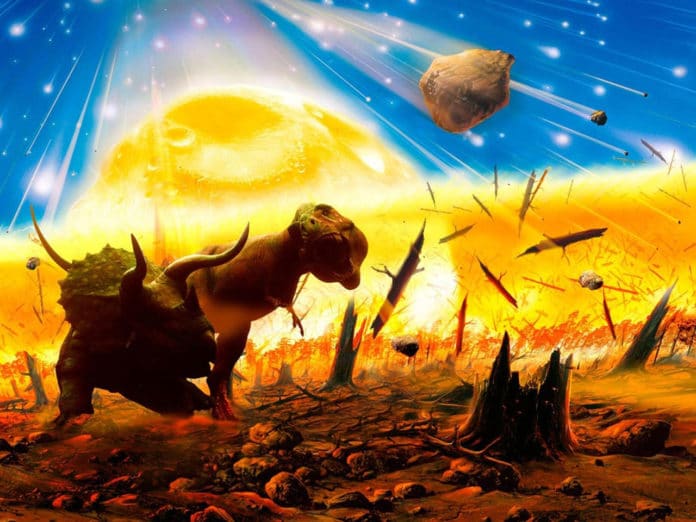Sixty-six million years ago, 70% of all species on land and in the seas, including the dinosaurs, suddenly went extinct in the disastrous aftermath of the collision of a large asteroid rock or comet with the Earth. Subsequently, paleontologists discovered that such mass extinctions of marine life, in which up to 90 percent of species disappeared, were not random events; instead, it follows a cycle of about 27 million years, according to a new study.
The study conducted by scientists from New York University also suggests that these mass extinctions align with significant asteroid impacts and devastating volcanic outpourings of lava called flood-basalt eruptions.
Michael Rampino, a professor in New York University’s Department of Biology, said, “It seems that large-body impacts and the pulses of internal Earth activity that create flood-basalt volcanism may be marching to the same 27-million-year drumbeat as the extinctions, perhaps paced by our orbit in the Galaxy.”
Based on examined records of mass extinctions of land-dwelling animals, scientists concluded that they coincided with ocean life’s extinctions. After performing statistical analyses of land species’ extinctions, scientists demonstrated that those events followed a similar cycle of about 27.5 million years.
What could be causing the periodic mass extinctions on land and in the seas? Mass extinctions are not the only events occurring in cycles: the ages of impact craters- made by asteroids and comets colliding with the Earth‘s surface- – likewise follow a cycle lining up with the extinction process.
Astrophysicists hypothesize that periodic comet showers occur in the Solar System every 26 to 30 million years, producing cyclical impacts resulting in periodic mass extinctions. The Sun and planets cycle through the crowded mid-plane of the Milky Way Galaxy about every 30 million years. During those times, comet showers are possible, leading to large impacts on the Earth. The impacts can create conditions that would stress and potentially kill off the land and marine life, including widespread dark and cold, wildfires, acid rain, and ozone depletion.
Rampino said, “These new findings of coinciding, sudden mass extinctions on land and in the oceans, and of the common 26- to 27-million-year cycle, lend credence to the idea of periodic global catastrophic events as the triggers for the extinctions. Three of the mass annihilations of species on land and in the sea are already known to have occurred at the same times as the three largest impacts of the last 250 million years, each capable of causing a global disaster and resulting mass extinctions.”
Scientists found another possible explanation beyond asteroids for mass extinctions: flood-basalt eruptions, or giant volcanic eruptions covering vast areas with lava.
All eight of the coinciding mass die-offs on land and in the oceans matched times of flood-basalt eruptions. These eruptions would have created severe conditions for life, including brief periods of intense cold, acid rain, ozone destruction, and increased radiation; longer-term, eruptions could lead to lethal greenhouse heating and more acid and less oxygen in the ocean.
Rampino said, “The global mass extinctions were caused by the largest cataclysmic impacts and massive volcanism, perhaps sometimes working in concert.”
Journal Reference:
- Michael R. Rampino et al. A 27.5-My underlying periodicity detected in extinction episodes of non-marine tetrapods. DOI: 10.1080/08912963.2020.1849178
